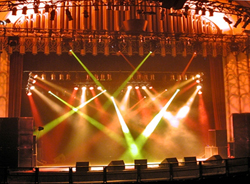
Source Four PAR: Years ago, this different version of a PAR was introduced by Electronic Theater Controls (ETC). A Source Four PAR (S-4 for short) fixture consists of a rugged housing with a glass or metal reflector that accepts interchangeable lenses providing beam spreads from very narrow (VN) to xtra wide flood (XWFL).
S-4 fixtures use an HPL lamp available in a variety of wattages and voltage configurations, with 575 and 750 watts being the most often seen on productions. Many other companies now make their own variations on the S-4 style fixture.
Audience Blinders: a.k.a Molefays, named after a fixture originally devised by the the Mole-Richardson Company. These are units that use four or more PAR type bulbs that are designed to light up a large area while filming a movie, but they are also popular in lighting up the audience during a concert.
PC Beams: These wash fixtures use a plano convex lens in front of the lamp and reflector that provides a sharp edged beam. Some units use stipples lenses to soften the beam. The width of the beam is usually adjustable by moving the lamp closer to or farther away from the lens.
Fresnels: These fixtures use a Fresnel lens in front of the lamp and reflector and provide a soft edged beam useful for washing a stage, especially when lighting for video or IMAG at an event.
Fresnels used in film range in size from very small 100-watt units with 2-inch lenses to larger 20000-watt units with with 24-inch lenses. Fresnels designed for stage lighting are usually in the 6- to 8-inch lens size and use lamps rated between 500-2000 watts, and they offer adjustable beam widths.
Lekos: This is a trade name from Strand that is now the generic term for an ellipsoidal reflector spotlight (ERS), a.k.a., “Profile” fixture. Lekos are lensed spotlights that offer focusing capability, as well as internal shutters that can shape and cut off the beam. They are often used for projecting patterns from Gobos as well as “specials” to highlight a performer onstage or an item of scenery.
Modern Lekos can take different lens barrels and offer from 5- to 90-degree beam angles. A variation of the ERS called the ZOOM allows the user to adjust the beam angle between a certain range, such as 15 to 30 degrees.
Follow Spots: Basically large Lekos, these are spotlights mounted on yokes and operated by hand and allow the operator to adjust the focus and size of the beam, add color and direct the beam onto performers.
Since many of the larger units use lamps that need time to restrike or ramp up to operating level, instead of turning off the bulb, the operator will shutter the shutter the light from exiting the follow spot, and leave the lamp on until the next cue.
Some of the newer units allow remote control of features like dimming, or color selection and allow the operator to concentrate on just aiming the fixture.
Intells: Available in both moving head and moving mirror styles, intelligent lights offer remote control over a wide variety of parameters including dimming, beam size, beam color, and even gobos.
A newer type unit is the moving projector style that allows an operator to aim and focus a high powered video projector around the venue or stage, projecting video images, patterns or just colors.
LED: Light emitting diodes come in a variety of fixture types and have started to replace many of the older style fixtures that use traditional lamps. This is in part because LEDs draw less power, produce little to no heat, and offer extremely long lamp life of up to 50,000 hours.
With built-in dimming and color mixing, they also save money by not having to use dimmer racks and multiple fixtures for different colors.
Craig Leerman is senior contributing editor for Live Sound International and ProSoundWeb, and is the owner of Tech Works, a production company based in Las Vegas.
